Our most recent TDKRA fieldwork took place from July 4-17 in Can Tho, Hanoi, and Thua Thien Hue Provinces of Vietnam. Here is a snapshot of what took place.
Objectives: The main objectives of the July fieldwork were:
1) To engage participants in reflexive practices on their participation through participatory analysis and filmmaking;
2) To foster the participants’ public engagement by strengthening their networks and strategies for collective activism;
3) To strengthen DPOs’ capacity and leaderships in relation to disability research and activism.
Activities: Our participatory activities include:
- Creating a documentary film through participatory film-making;
- Conducting participatory narrative analysis using multimodal (multi-media) texts;
- Creating photovoice projects that represent the voices of the women and girls with disabilities in three different communities;
- Getting participants involved in identifying their communities and social locations, and engaging them in critical consciousness of their own valuable contributions to the communities.
Methodologies: We used a participatory approach as a part of decolonizing methodologies which aimed to enable the participants to construct their own meaning. In this fieldwork, we used arts-based research, including photo-voice and participatory film-making, as well as community asset mapping, as a part of the participatory research paradigm which engaged with the local community. Participatory research is a research paradigm that is grounded in the values of the community. It aims to contribute something of value to the community in which the research is conducted (Kirby, Greaves, & Raid, 2006). This paradigm of research enables the researcher and the researched to engage in mutual dialogues in ways that value the participants’ voices and perspectives.
Procedures: Organized in the form of a workshop, each local fieldwork included a number of participatory activities which allowed the girls and women with disabilities to share their ideas about inclusion and exclusion by developing ideas for film-making, creating arts-based projects, and sharing them with one another in a way that shapes their collective voices and perspectives. In each location, we adapted research activities drawing on the local resources and the specific needs of participants. For example, participants identified their own social locations through a Community Asset Mapping activity, which enabled them to reimagine their social positionings by envisioning and re-envisioning accessible spaces where they belong or want to belong. The girls and women traced their ways to school, soccer fields, health care facilities, and community centers.
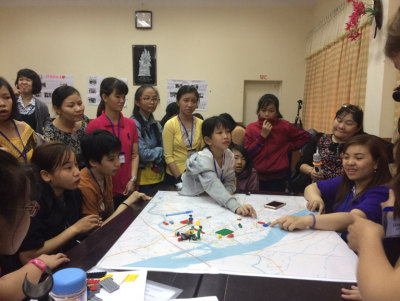
A group identifies their local community through a Community Asset Mapping activity in Can Tho
Outcomes: This fieldwork fostered more meaningful engagement among the girls, women, their Disabled People’s Organizations (DPOs), and the research team in the global North and South (Nguyen, 2016; Stienstra & Nguyen, forthcoming). In a land-based activity using photovoice in Bac Tu Liem, for example, each group created their own stories. They used the dry leaves in the schoolyard and mounted these on their posters to respond to the prompt “Place where we belong and do not belong.”
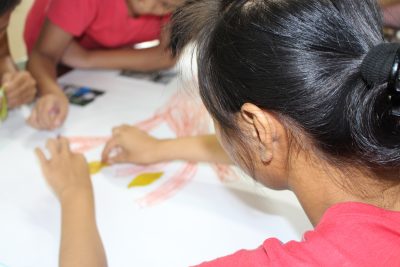
A girl with disabilities creates her art project about “Diversity and difference” using dry leaves and photovoice
Reflecting on their own narratives through the use of composite stories as a part of participatory analysis, the participants discussed these stories, whether the stories reflected their own narratives, and the similarities and differences among those stories to get more meaningful understanding of the situations of girls and women across the communities.
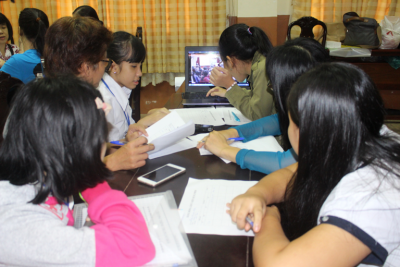
A group of girls and women with disabilities watched their composite stories through a participatory data analysis activity in Can Tho
The participants used cameras to create their own ways of seeing, re-imagining their own stories through the photovoice project.
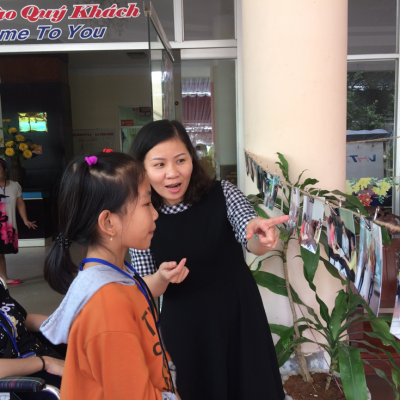
A girl and woman with disabilities viewed their own photos through a photovoice project in Can Tho
The participants then discussed the idea of making changes. Some believed that changes should come from both sides: the community of people with disabilities, and their local communities. That is, people with disabilities should become more confident in their capacities to participate in social activities. They should ‘speak back’ when being teased or looked down by able-bodied and ethnic majority peers. The girls wanted their teachers to listen to them and be understanding of their disabilities. Changes need to be initiated by everyone in the community: “Everyone helps and shares with each other.”
A film crew was hired to produce a participatory documentary film with the participants, based on the participants’ input and the principles of respect, engagement, and participation in co-producing knowledge. The participants then used the final day of the workshop to contribute their ideas for editing the rough cut of their own participation created by the film crew, thereby ensuring that their perspectives are listened and included in the participatory film-making process.
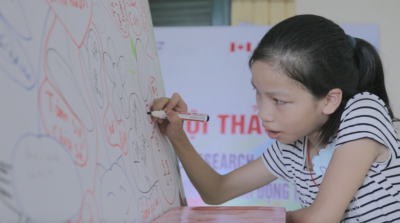
A girl is generating ideas on ‘participation’ for participatory film-making in Hanoi
When asked what footage they would like to maintain in a short cut of the participatory film made for their own local district, the participants wanted to show their own images and engagement in the film. We saw not only the participants’ feeling of being empowered through their self-confidence, but also their tears and emotions while reflecting on what they had gone through in their lives.
The local DPO successfully organized the workshops through their disability networks. Despite the lack of local resources, they felt stronger and more capable in engaging in the research activities.
References
Nguyen, X. T. 2016. Girls with Disabilities in the Global South: Rethinking the Politics of Engagement. Girlhood Studies: An interdisciplinary Journal, 9, 53-71.
Stienstra, D. & Nguyen, X. T. in press. Opening to the Possible: Girls and Women with Disabilities Engaging in Vietnam. In: WIEBE, S. M. & LEVAC, L. (eds.) Creating spaces for engagement. Toronto: University of Toronto Press.